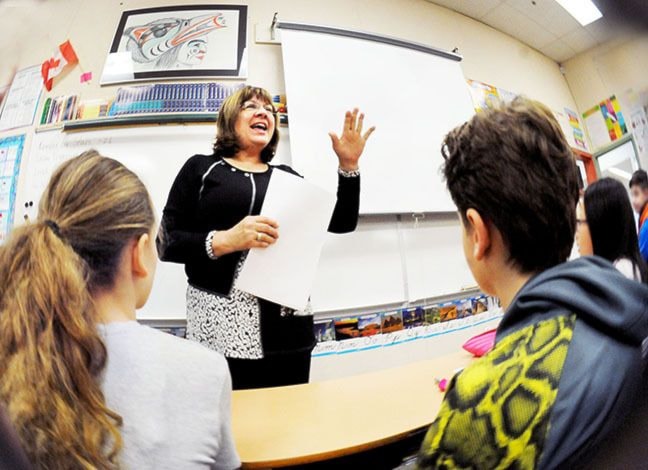More teachers are on their way to Langley classrooms.
The news comes after the province and B.C. Teachers Federation negotiated an interim settlement to their long-running dispute over staffing levels, a $50 million fund to hire up to 1,100 teachers for the current school year.
Education Minister Mike Bernier stressed there will be additional ongoing funding in the B.C. Liberal government’s February budget to finance a full agreement.
Langley School District superintendent Gord Stewart said this announcement will pave the way for more staffing in local schools.
“Here in Langley we are looking at possibly 35 to 40 new teachers in the next while,” Stewart predicted.
“As more details come out regarding the ministry announcement, we’ll know better how it will look exactly, but the district is working closely with the Langley Teachers’ Association to set things in motion and begin to map out how the deployment may look.”
The postings are going out as soon as possible and new teachers will be hired as suitable candidates are found, noted district communications manager Ken Hoff.
“As for the implementation and deployment, we are working closely with the Langley Teachers’ Association to determine how that will look – resource teachers, teacher-librarians, special needs teachers, classroom teachers – how it will pan out has not been finalized but the goal is to move forward as quickly as possible to get teachers in schools,” Hoff added. “According to the district’s HR Department, there could be positions filled by the end of the month.”
The actual number of teachers hired will be determined by school districts and their local unions. The new positions will include classroom teachers, special education teachers, speech language pathologists, behaviour intervention specialists, school psychologists, aboriginal support teachers, counsellors including for mental health, English as a second language teachers, and teacher librarians.
Langley Teachers’ Association president Wendy Cook said the local union worked with the district Friday on establishing the process for this first step in hiring.
“When I say first step, it is because we anticipate even more funds to be coming, in order to reinstate enrolling and non-enrolling teachers back into positions,” Cook told the Times.
Enrolling teachers work with students in standard classrooms, while non-enrolling teachers, such as counsellors, librarians and speech language pathologists, do not.
Cook said she contacted Stewart right after the conference call with the BCTF table officers “so that we could establish a process and on Friday morning we, LTA table officers (elected members of the LTA executive who are released either full or part time from their teaching duties), met with representatives from the board office to establish an initial process for reinstatement.”
The LTA is excited to “get moving,” noted Cook, but once again realize that this is one of the first steps in re-establishing the stripped language.
“There were students who went through the system when all the proper supports were not in place and if it wasn’t for the dedication of the teachers, who together with other staff at the schools took on the extra work loads to make the learning experience positive, that the school system managed,” Cook said.
Cook said she’s excited to be “moving in the right direction once again, and it was a long struggle to get to this point.”
“I am glad we are working with the school district to re-establish all that was lost and this is only the first step,” Cook said. “We will continue to discuss placements with the district, next week, and posting of positions.”
Last week’s announcement is a step toward the end of a lengthy legal battle between the government and the union that first began in 2002, when then-education minister Christy Clark removed class size and special needs support staffing ratios from the union contract.
The dispute went all the way to the Supreme Court of Canada, which ruled in the teachers’ favour in November 2016.
Cook said her son started school the year the collective agreement was “stripped by the Liberals (and) Christy Clark,” adding that it took eight years to get a diagnosis for him.
“How many other students were impacted by this?” Cook wondered.
B.C. Teachers’ Federation president Glen Hansman said the interim agreement means more teachers “in a matter of weeks,” but the union and the government will resume meetings next week to restore the 2002 contract language upheld by the courts.
“It’s going to take a significantly higher investment than $50 million to undo the damage this government has done to a generation of students,” Hansman said.
“B.C. teachers will be looking closely at the Feb. 21 provincial budget to make sure that funding is provided to implement the full scope of the restored language.”
NDP education critic Rob Fleming said the agreement represents a “down payment on restoring 15 years of cuts” to B.C. public schools, after the B.C. Liberal government spent millions on lawyers to defend their actions and was finally forced to restore funding.
“We have something like 15,000 classrooms in British Columbia right now that are out of compliance, even with the government’s own guidelines, so they’re already behind in the absence of hard targets,” Fleming said.
Where will the teachers go?
There is still the question of where to put the new teachers.
Staff capacity is one of the factors that the province will consider when doling out the new funding to each school district.
Many schools in the Lower Mainland are overcrowded, especially those in more developed areas such as Langley and Surrey, Chilliwack and Maple Ridge.
Bernier said last week that other factors to be considered are class timetables, labour supply limitations, and physical space.
— Files from Ashley Wadhwani, Black Press
